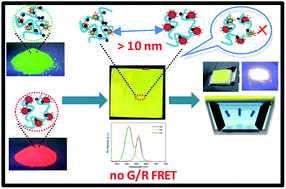Preparation of quantum dot/polymer light conversion films with alleviated Förster resonance energy transfer redshift†
Abstract
Hybrid quantum dot (QD)/polymer light conversion (QDPLC) films containing QDs of two or more emission colors in a high concentration are subject to inter-dot Förster resonance energy transfer (FRET), which causes an intractable photoluminescence (PL) redshift and therefore renders the desired PL color of the conversion film unfeasible. Accordingly, the present study proposes a straightforward approach for preparing QDPLC films containing green- and red-emission QD nanoclusters (5–20 nm) with a separation distance greater than 10 nm. Comparing the PL spectrum of the hybrid QDPLC film with those of films comprising only green- or red-emission QD nanoclusters, a redshift phenomenon is not observed. In other words, FRET from the green-emission QDs to the red-emission QDs (G/R FRET) does not occur. The QDPLC film is transferred onto a blue LED chip (460 nm) in order to realize a white-light-emitting device (WLED). It is shown that the WLED has CIE color coordinates of (0.282, 0.296), a correlated color temperature (CCT) of 9492 K, a color-rendering index (CRI) of 69, and a luminance efficiency (LE) of 40.4 lm W−1 under a forward current of 20 mA.


 Please wait while we load your content...
Please wait while we load your content...